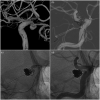Balloon-assisted coiling of intracranial aneurysms using the Eclipse 2L double lumen balloon
- PMID: 31930938
- PMCID: PMC7254628
- DOI: 10.1177/1591019919895676
Balloon-assisted coiling of intracranial aneurysms using the Eclipse 2L double lumen balloon
Abstract
Background: Eclipse 2L is a new double lumen balloon microcatheter for neurovascular use, with several design features that separate it from previous generation devices. We aimed to report our initial experience of balloon-assisted coiling of intracranial aneurysms using the Eclipse 2L balloon.
Materials and methods: Retrospective single-center review of patients who underwent balloon-assisted coiling with the Eclipse 2L balloon, for ruptured or unruptured intracranial aneurysms between 1 June 2016 and 31 December 2018. Cases with adjunctive use of stents and recurrences of previously embolized aneurysms were excluded. Patient files were used to extract aneurysm characteristics, complications, immediate and long-term results.
Results: We identified 120 patients with 126 aneurysms, of which 83 (65.8%) unruptured. Average aneurysm size was 5.9 mm (standard deviation 3.2 mm), with a dome-to neck-ratio of 1.7 (SD 0.6). Most aneurysms (79.3%) were wide necked. Immediate angiographic exclusion (Raymond-Roy grade I-II) was obtained in 95.1% of cases (81.7% grade I and 13.4% grade II). Procedural morbidity was 3.2% with no procedural mortality. Follow-up imaging was available for 115 aneurysms (91.2%). After an average follow-up period of 8.9 months (SD 7.3 months), 96.5% of aneurysms presented class I-II occlusion. Two aneurysms (1.7%) were retreated during follow-up.
Conclusion: Balloon-assisted coiling using the Eclipse 2L double lumen balloon is feasible for aneurysms in a wide range of locations in the anterior and posterior circulation. The angiographic results and complication rates compare favorably with previously published studies.
Keywords: Double lumen balloon; coil; embolization.
Figures



References
-
- Martinez-Galdamez M, Orlov K, Kadziolka K, et al. Safety and efficacy of intracranial aneurysm embolization using the “combined remodeling technique”: low-profile stents delivered through double lumen balloons: a multicenter experience. Neuroradiology 2019; 61: 1067–1072. - PubMed
-
- Wallace AN, Kayan Y, Delgado Almandoz JE, et al. Endovascular treatment of wide-necked intracranial aneurysms with the Scepter XC balloon catheter, with low-profile visualized intraluminal support (LVIS) Jr. deployment as a “Bailout” Technique. World Neurosurg 2019; 121: e798–e807. - PubMed
MeSH terms
LinkOut - more resources
Full Text Sources
Medical

